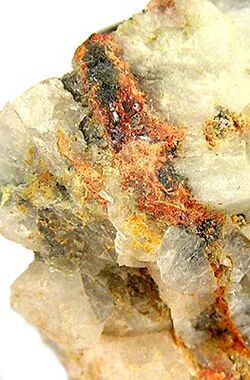Chemistry:Montroydite
From HandWiki
Short description: Mercury(II) oxide mineral, HgO
| Montroydite | |
|---|---|
 Vein of dark red montroydite and orange kleinite in a matrix of white calcite | |
| General | |
| Category | Oxide mineral |
| Formula (repeating unit) | HgO |
| Strunz classification | 4.AC.15 |
| Crystal system | Orthorhombic |
| Crystal class | Dipyramidal (mmm) H-M Symbol: (2/m 2/m 2/m) |
| Unit cell | a = 5.52 Å, b = 6.6 Å, c = 3.52 Å; Z=4 |
| Identification | |
| Color | Deep red, brownish red to brown |
| Crystal habit | Long prismatic, equant, rarely flattened; striated; massive to vermicular clusters |
| Cleavage | Perfect {010} |
| Tenacity | Sectile |
| Mohs scale hardness | 1.5 - 2.0 |
| |re|er}} | Sub-adamantine, vitreous |
| Streak | Yellow brown |
| Diaphaneity | Transparent to translucent |
| Specific gravity | 11.23 |
| Optical properties | Biaxial (+) |
| Refractive index | nα = 2.370 nβ = 2.500 nγ = 2.650 |
| Birefringence | δ = 0.280 |
| Pleochroism | Deep red-orange to yellowish brown (visible in thick sections) |
| 2V angle | Large |
| References | [1][2] |
Montroydite is the mineral form of mercury(II) oxide with formula HgO. It is a rare mercury mineral. It was first described for an occurrence in the mercury deposit at Terlingua, Texas and named for Montroyd Sharp who was an owner of the deposit.[1]
Montroydite occurs in mercury deposits of hydrothermal origin. Associated minerals include: native mercury, cinnabar, metacinnabar, calomel, eglestonite, terlinguaite, mosesite, kleinite, edgarbaileyite, gypsum, calcite and dolomite.[2]
References
- ↑ 1.0 1.1 Mindat.org
- ↑ 2.0 2.1 "Handbook of Mineralogy". http://www.handbookofmineralogy.com/pdfs/montroydite.pdf.
- ↑ Warr, L.N. (2021). "IMA–CNMNC approved mineral symbols". Mineralogical Magazine 85 (3): 291–320. doi:10.1180/mgm.2021.43. Bibcode: 2021MinM...85..291W.
 |

